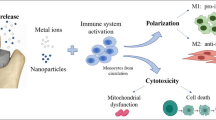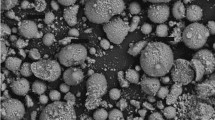Abstract
The cytotoxicity caused by the debris resulting from wear of prostheses can produce major damage to tissues around the implant. We have compared particle internalization by macrophages and fibroblastsin vitro and analyzed cell death. J774.2 macrophages and L929 fibroblasts were incubated with 0.43 and 2.81 μm alumina particles or 0.45 and 3.53 μm polystyrene (PS) beads. Incubation of J774.2 cells with alumina particles of both sizes and 0.5 and 1.0 mg/ml PS beads significantly decreased cell numbers in a particle concentration-dependent manner. L929 cells were not affected by lower concentrations of 0.43 μm alumina particles (which aggregate at high concentrations) and they internalized 0.45 μm PS beads without any decrease in cell numbers. Particles were more cytotoxic for macrophages than for fibroblasts. Particles caused the size of both types of cells to increase in correlation with cytotoxicity. Trypan blue exclusion and lactate dehydrogenase release showed cell membrane leakage for both types of cells incubated with PS beads for 24 h. Apoptosis was assessed by annexin V–FITC, propidium iodide staining and assay of caspase 3 activity. Macrophage death appeared to depend on both necrosis, caused mainly by 3.53 μm PS beads, and apoptosis, mainly due to 0.45 μm PS beads. The release of the inflammatory cytokine IL-6 appears to be nonlinearly correlated with cytotoxicity. Thus, the size of the internalized particles affects macrophages and fibroblasts differently, and the increase in cell size can be used as a preliminary criterion of particle cytotoxicityin vitro.
Similar content being viewed by others
References
Bentley SA, Tralka TS, Alabaster O. Phagocytic properties of bone marrow fibroblasts. Exp Hematol. 1981;9:313-18.
Catelas I, Huk OL, Petit A, Zukor DJ, Marchand R, Yahia L. Flow cytometric analysis of macrophage response to ceramic and polyethylene particles: effects of size, concentration, and composition. J Biomed Mater Res. 1998;41:600-7.
Catelas I, Petit A, Zukor DJ, Marchand R, Yahia L, Huk OL. Induction of macrophage apoptosis by ceramic and polyethylene particles in vitro. Biomaterials. 1999a;20:625-30.
Catelas I, Petit A, Marchand R, Zukor DJ, Yahia L, Huk OL. Cytotoxicity and macrophage cytokine release induced by ceramic and polyethylene particles in vitro. J Bone Joint Surg Br. 1999b;81:516-21.
Catelas I, Petit A, Zukor DJ, Antoniou J, Huk OL. TNF-alpha secretion and macrophage mortality induced by cobalt and chromium ions in vitro -- qualitative analysis of apoptosis. Biomaterials. 2003;24:383-91.
Ciapetti G, Savarino L, Giunti A, et al. Effects of two-FE-based superalloy particles on osteoblast-and macrophages-like cells. 17th European Society for Biomaterials Conference, Barcelona, Spain. 2002.
Decker T, Lohmann-Matthes ML. A quick and simple method for the quantitation of lactate dehydrogenase release in measurements of cellular cytotoxicity and tumor necrosis factor (TNF) activity. J Immunol Methods. 1988;115:61-9.
Evans EJ. Cell damage in vitro following direct contact with fine particles of titanium, titanium alloy and cobalt-chrome-molybdenum alloy. Biomaterials. 1994;15:713-17.
Frondoza CG, Tanner KT, Jones LC, Hungerford DS. Polymethylmethacrylate particles enhance DNA and protein synthesis of human fibroblasts in vitro. J Biomed Mater Res. 1993;27:611-17.
Germain MA, Hatton A, Williams S, et al. Comparison of the cytotoxicity of clinically relevant cobalt-chromium and alumina ceramic wear particles in vitro. Biomaterials. 2003;24:469-79.
Glant TT, Jacobs JJ, Mikecz K, et al. Particulate-induced, prostaglandin-and cytokine-mediated bone resorption in an experimental system and in failed joint replacements. Am J Ther. 1996;3:27-41.
Green TR, Fisher J, Stone M, Wroblewski BM, Ingham E. Polyethylene particles of a “critical size” are necessary for the induction of cytokines by macrophages in vitro. Biomaterials. 1998;19:2297-302.
Greis PE, Georgescu HI, Fu FH, Evans CH. Particle-induced synthesis of collagenase by synovial fibroblasts: an immunocytochemical study. J Orthop Res. 1994;12:286-93.
Hatton A, Nevelos JE, Nevelos AA, Banks RE, Fisher J, Ingham E. Alumina-alumina artificial hip joints. Part I: a histological analysis and characterisation of wear debris by laser capture microdissection of tissues retrieved at revision. Biomaterials. 2002;23:3429-40.
Henssge EJ, Bos I, Willman G. A12O3 angainst A12O3 combination in hip endoprostheses. Histologic investigations with semi-quantitative grading of revision and autopsy cases and abrasion measures. J Mater Sci Mater Med. 1994;5:657-61.
Homburg CH, de Haas M, von dem Borne AE, Verhoeven AJ, Reutelingsperger CP, Roos D. Human neutrophils lose their surface Fc gamma RIII and acquire Annexin V binding sites during apoptosis in vitro. Blood. 1995; 85: 532-40.
Horowitz SM, Luchetti WT, Gonzales JB, Ritchie CK. The effect of cobalt chromium upon macrophages. J Biomed Mater Res. 1998;41:468-73.
Humphreys DT, Wilson MR. Modes of L929 cell death induced by TNF-alpha and other cytotoxic agents. Cytokine. 1999;11:773-82.
Huppertz B, Frank HG, Kaufmann P. The apoptosis cascade morphological and immunohistochemical methods for its visualization. Anat Embryol. 1999;200:1-18.
Kadoya Y, Kobayashi A, Ohashi H. Wear and osteolysis in total joint replacements. Acta Orthop Scand Suppl. 1998;278:1-16.
Karpinish NO, Tafani M, Rothman RJ, Russo MA, Farber JL. The course of etoposide-induced apoptosis from damage to DNA and p53 activation to mitochondrial release of cytochrome c. J Biol Chem. 2002;277:16547-52.
Kohilas K, Lyons M, Lofthouse R, Frondoza CG, Jinnah R, Hungerford DS. Effect of prosthetic titanium wear debris on mitogen-induced monocyte and lymphoid activation. J Biomed Mater Res. 1999;47:95-103.
Korzeniewski C, Callewaert DM. An enzyme-release assay for natural cytotoxicity. J Immunol Methods. 1983;64: 313-20.
Lind M, Trindade MC, Yaszay B, Goodman SB, Smith RL. Effects of particulate debris on macrophage-dependent fibroblast stimulation in coculture. J Bone Joint Surg. 1998;80:924-30.
Los M, Mozoluk M, Ferrari D, et al. Activation and caspase-mediated inhibition of PARP: a molecular switch between fibroblast necrosis and apoptosis in death receptor signaling. Mol Biol Cell. 2002;13: 978-88.
Matthews JB, Besong AA, Green TR, et al. Evaluation of the response of primary human peripheral blood mononuclear phagocytes to challenge with in vitro generated clinically relevant UHMWPE particles of known size and dose. J Biomed Mater Res. 2000;52:296-307.
Manlapaz M, Maloney WJ, Smith RL. In vitro activation of human fibroblasts by retrieved titanium alloy wear debris. J Orthop Res. 1996;14:465-4-2.
McConkey DJ. Biochemical determinants of apoptosis and necrosis. Toxicol Lett. 1998;99:157-68.
Morhenn VB, Lemperle G, Gallo RL. Phagocytosis of different particulate dermal filler substances by human macrophages and skin cells. Dermatol Surg. 2002;28:484-90.
Mostardi RA, Meerbaum SO, Kovacik MW, Gradisar IA Jr. Response of human fibroblasts to tantalum and titanium in cell culture. Biomed Sci Instrum. 1997;33:514-18.
Mostardi RA, Meerbaum SO, Kovacik MW, Gradisar IA Jr. In vitro response of human fibroblasts to commercially pure titanium. J Biomed Mater Res. 1999;47:60-4.
Ninomiya JT, Struve JA, Stelloh CT, Toth JM, Crosby KE. Effect of hydroxyapatite particulate debris on the production of cytokines and proteases in human fibroblasts. J Orthop Res. 2001;19:621-8.
Osano E, Kishi J, Takahashi Y. Phagocytosis of titanium particles and necrosis in TNF-alpha-resistant mouse sarcoma L929 cells. Toxicol In Vitro. 2003;17:41-7.
Petit A, Catelas I, Antoniou J, Zukor DJ, Huk OL. Differential apoptotic response of J774 macrophages to alumina and ultra-high-molecular-weight polyethylene particles. J Orthop Res. 2002;20: 9-15.
Prabhu A, Shelburne CE, Gibbons DF. Cellular proliferation and cytokine responses of murine macrophage cell line J774 A.1 to polymethylmethacrylate and cobalt-chrome alloy particles. J Biomed Mater Res. 1998;42:655-63.
Renwick LC, Donaldson K, Clouter A. Impairment of alveolar macrophage phagocytosis by ultrathin particles. Toxicol Appl Pharmacol. 2001;172:119-27.
Ruetten H, Thiemermann C. Interleukin-13 is a more potent inhibitor of the expression of inducible nitric oxide synthase in smooth muscle cells than in macrophages: a comparison with interleukin-4 and interleukin-10. Shock 1997;8:409-14.
Salzman GC, Singham SB, Johnston RG, Bohren CF. Light scattering and cytometry. In: Melamed MR, Lindmo T, Mendelsohn ML, eds. Flow cytometry and sorting. New York: Wiley-Liss; 1990:81-107.
Shanbhag AS, Jacobs JJ, Black J, Galante JO, Glant TT. Macrophage/particle interactions: effect of size, composition and surface area. J Biomed Mater Res. 1994;28:81-90.
Shim SR, Kook S, Kim JI, Song WK. Degradation of focal adhesion proteins paxillin and p 130cas by caspases or calpains in apoptotic rat-1 and L929 cells. Biochem Biophys Res Commun. 2001;24:601-8.
Stea S, Visentin M, Granchi D, et al. Apoptosis in peri-implant tissue. Biomaterials. 2000;21:1393-8.
Stoika R, Kashchak N, Lutsik-Kordovsky M, Boyko M, Tsyrulnyk A. In vitro response of phagocytic cells to immunomodulating agents. Med Sci Monit. 2001;7:652-8.
Tengku-Muhammad TS, Cryer A, Ramji DP. Synergism between interferon gamma and tumor necrosis factor alpha in the regulation of lipoprotein lipase in the macrophage J774.2 cell line. Cytokine. 1998;10:38-48.
Tengku-Muhammad TS, Hughes TR, Cryer A, Ramji DP. Involvement of both the tyrosine kinase and the phosphatidylinositol-3′ kinase signal transduction pathways in the regulation of lipoprotein lipase expresion in J774.2 macrophages by cytokines and lipopolysaccharide. Cytokine. 1999;11:463-8.
Torché AM, Albina E, Le Corre P, Jestin A, Le Verge R. Flow cytometric and optical microscopic evaluation of poly(D,L-lactide-co-glycolide) microspheres phagocytosis by pig alveolar macrophages. J Control Release. 1999;58:289-301.
Trindade MC, Schurman DJ, Maloney WJ, Goodman SB, Smith RL. G-protein activity requirement for polymethylmethacrylate and titanium particule-induced fibroblast interleukin-6 and monocyte chemoattractant protein-1 release in vitro. J Biomed Mater Res. 2000;51:360-8.
Trindade MC, Lind M, Sun D, Schurman DJ, Goodman SB, Smith RL. In vitro reaction to orthopaedic biomaterials by macrophages and lymphocytes isolated from patients under-going revision surgery. Biomaterials 2001a;22:253-9.
Trindade MC, Lind M, Nakashima Y, et al. Interleukin-10 inhibits polymethylmethacrylate particle induced interleukin-6 and tumor necrosis factor-alpha release by human monocyte/macrophages in vitro. Biomaterials. 2001b;22:2067-73.
Vercammen D, Brouckaert G, Denecker G, et al. Dual signaling of the Fas receptor: initiation of both apoptotic and necrotic cell death pathways. J Exp Med. 1998;188:919-30.
Verhoven B, Schlegel RA, Williamson P. Mechanisms of phosphatidylserine exposure, a phagocyte recognition signal, on apoptotic T lymphocytes. J Exp Med. 1995;182:1597-601.
Vermes I, Haanen C, Steffens-Nakken H, Reutelingsperger C. A novel assay for apoptosis. Flow cytometric detection of phosphatidylserine expression on early apoptotic cells using fluorescein labelled Annexin V. J Immunol Methods. 1995;184:39-51.
Yao J, Glant TT, Lark MW, et al. The potential role of fibroblasts in periprosthetic osteolysis: fibroblast response to titanium particles. J Bone Miner Res. 1995;10:1417-27.
Yoon TR, Rowe SM, Jung ST, Seon KJ, Maloney WJ. Osteolysis in association with a total hip arthroplasty with ceramic bearing surfaces. J Bone Joint Surg Am. 1998;80:1459-68.
Author information
Authors and Affiliations
Rights and permissions
About this article
Cite this article
Olivier, V., Duval, JL., Hindié, M. et al. Comparative particle-induced cytotoxicity toward macrophages and fibroblasts. Cell Biol Toxicol 19, 145–159 (2003). https://doi.org/10.1023/A:1024723326036
Issue Date:
DOI: https://doi.org/10.1023/A:1024723326036




